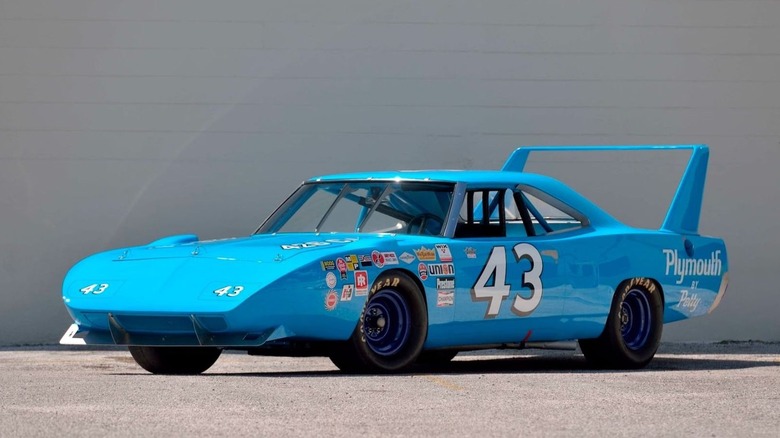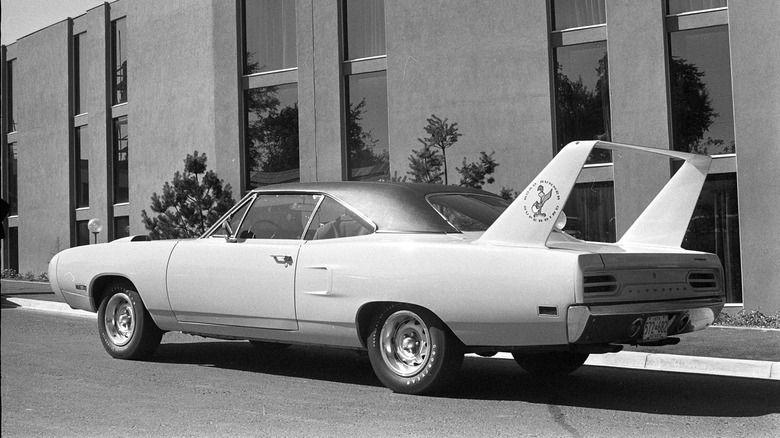The Interesting Story Behind NASCAR Banning The 1970 Plymouth Superbird
Fans of NASCAR know the name Richard Petty. "The King" retired in 1992 but is still the greatest driver the motorsport has ever seen. Petty has a litany of "mosts" including wins, wins in a season, consecutive wins, poles, and starts. He's tied with only two other drivers — Dale Earnhardt and Jimmie Johnson — for most career championships (each with seven). Petty raced from 1958 to 1992, compiled a staggering 1,185 starts, 200 wins, and held the pole position 123 times. The man is a certified legend.
At the beginning of his career, Petty raced Oldsmobiles, but from 1958 through 1968, he drove nothing by Plymouths. During the 1968 season, Chrysler announced it was coming out with a new version of its Dodge Charger with enhanced aerodynamic features and would start racing it in the 1969 season. It sported a shark-like nose cone on the front that dipped down to the ground and a rear spoiler that stuck nearly 40 inches off the back lid. It looked bizarre because it was so "radically different" from any others on the track.
Despite the time, money, and effort Dodge was putting into its next-generation racer, Plymouth did absolutely nothing. At the time, Chrysler's brands and racing teams were independent groups fighting amongst and against themselves (via Autoweek). Petty saw the new Dodge Charger and wanted one of his own, but Plymouth saw no need to "fix" anything with his #43 Belvedere model, because he had just come off the 1967 season having won 27 races — a record that still stands today.
The once and future king
This did not sit well with Petty. In 1968 he only won 16 races. Despite constantly haranguing Plymouth for a new winged stallion, the car manufacturer never budged. So, in 1969 Petty turned his back on Plymouth and zipped around the track in a Ford Torino Cobra instead. Petty didn't win the championship that year, but he came in second. Fellow Ford driver David Pearson, also driving a Torino, won it all. Dodge's winged #6 Charger, driven by Buddy Baker, finished back in 22nd place.
But Plymouth got the hint and realized it needed to do something to entice "The King" back to the throne, so it pulled out all the stops. Enter Gary Romberg, a legitimate rocket scientist, who worked for NASA on the space program during the 1960s. Before helping out with the Saturn B-1 booster rocket for America's space agency, Romberg worked for Boeing as a flight test engineer, and he knew a thing or two about making things go fast.
Romberg was hired in early 1969, and he and his team immediately went about banging out a new ride. They started by using the old Belvedere model Petty used to run, fitting it with a similar shark-like front end and raised wing spoiler seen on the Dodge Charger. But even after spending two months inside a small wind tunnel at Wichita State University, the team couldn't get the aerodynamics streamlined enough.
Meanwhile, Plymouth was working on "The King" himself, sending a high-level executive to his home in North Carolina and asking Petty what it would take for him to come back. Petty's answer was simple, "Build me a Plymouth like the Dodge teams had" (via Autoweek).
Plymouth finally found its wings
Romberg and his team ditched the Belvedere and shifted efforts to modifying a Road Runner body with the shark nose and wing. That turned out to be the golden ticket and got everything to Romberg's liking. They named it the Superbird after the "Beep, Beep" Looney Tunes character and showed it off to Petty. He was convinced and returned to driving for Plymouth the following year.
In the early days of NASCAR, one of the requirements for getting a car on the track was that manufacturers had to build and sell at least 500 road-worthy vehicles to the general public. These were "stock" cars, after all. That rule later changed, forcing companies to build one "showroom car" for every two dealers in Chrysler's network. In this case, it had to make 1,923 road versions of the Superbird.
The 426-cubic inch Hemi V8 engines in the winged Dodge Charger and Superbird lit up the super speedways. Petty won 18 races while Pete Hamilton, also part of the Plymouth team, won three. Bobby Isacc won 11 races in his Charger and would win the championship that year. Three other drivers (Bobby Allison, Charlie Glotzbach, and Buddy Baker) won another six races. Baker's 1970 winged Charger was the first NASCAR to go 200 miles an hour (at Daytona). Of the 48 total races in the 1970 NASCAR season, 38 were won by winged cars.
They were so dominant, in fact, that NASCAR dropped the ban hammer on the lot of them for the upcoming '71 season. While they didn't eliminate the wing outright, they did restrict the engine size so drastically (going from a 426-cid down to a 305-cid) that it all but neutered the aerodynamic design (via Autoweek).

